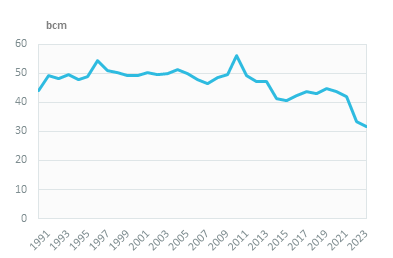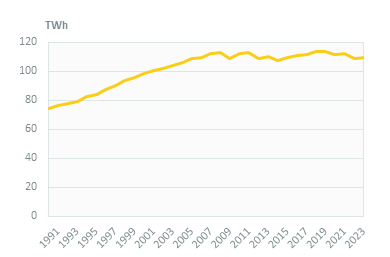-
-
 Energy and Climate Databases
Energy and Climate Databases- The most comprehensive and up-to-date annual energy database.
- Monitoring of technology providers in H2 supply chain.
- Monthly energy data on key energy markets.
- The most reliable and up-to-date power generation database.
- The essentials of LNG trade at your fingertips.
- Global monitoring of new and existing refineries.
- Analyse energy consumption and efficiency trends at world level. Benchmark countries.
- Have your database developed by a recognised expert of both energy and IT.
-
 Energy - Climate Forecasts
Energy - Climate Forecasts- Instant access to energy and emissions forecasts.
- Strategic, annual wholesale price projections backed by Enerdata's energy modelling expertise and our globally recognised POLES model.
- Wedges module showing a breakdown of the levers enabling to reduce emissions between two scenarios.
- Unique, independent projections of consumption by end-use.
- GHG Marginal Abatement Cost Curves.
- Benefit from proven models to draw your own energy scenarios and anticipate tomorrow’s challenges.
-
 Market Intelligence
Market Intelligence- 110 Energy and climate country reports
- A newsletter to receive the latest updates on evolving technologies and policies.
- Global energy news and analyses curated daily.
- Enerdata’s experts bring you the essentials about your market and competitors.
-
-
-
 Market Analysis
Market Analysis- Understanding key consumption trends and drivers across sectors.
- Granular and exclusive insight to address the most pressing business and strategic issues.
- Expertise in strategic and business intelligence, with fine-tuning to the market’s specificities.
-
 Energy - Climate Scenarios
Energy - Climate Scenarios- Providing the outlook of an energy commodity in mid to long term time horizons.
- Sector and driver specific energy demand forecasting.
- Assess the evolution of energy prices on the international and regional markets, as well as end-users prices.
- Enerdata guides you through pathways to reach climate targets.
- Supporting local authorities in their decarbonisation strategies.
-
 Climate Strategy and Policy Evaluation
Climate Strategy and Policy Evaluation- Cutting-edge quantitative tools and relevant indicators to monitor and evaluate evolutions on worldwide energy markets.
- Analysis of the most cost-effective options to reduce emissions.
- Quantified simulation and analysis of pledges for climate change negotiations.
- Breakdown and analysis of carbon markets.
- Enerdata guides you on the most beneficial policy or investment options.
- Turning climate objectives into concrete action plans.
-
 Training
Training- Understand different policy targets and measures on energy efficiency.
- How to measure energy savings?
- Energy Forecasting is a 2 days training to learn to design and interpret energy forecasts.
- Energy statistics training allowing to create energy balance with supply, transformation and consumption and understanding the international energy statistics regulations.
- Initiation to EnerMED level 1is the training to approach on the most powerful energy demand forecasting model.
-
-
Resource Centre
Netherlands Key Figures
- Population:
- 17.9 million
- GDP growth rate:
- 0.09 %/year
- Energy independence:
- 31.9%
Data of the last year available: 2023
- Total consumption/GDP:*
- 59.7 (2005=100)
- CO2 Emissions:
- 6.94 tCO2/capita
- Rate of T&D power losses:
- 4.22%
* at purchasing power parity
View all macro and energy indicators in the Netherlands energy report
Netherlands Related News
View all news, archive your new and create your own daily newsletters only on your topics/countries of interest with Key Energy Intelligence
Netherlands Related Research
Benefit from up to 2 000 up-to-date data series for 186 countries in Global Energy & CO2 data
A data overview is available in the global energy statistics app
Total Energy Consumption
Energy consumption per capita reached 3.4 toe in 2023 and is 17% higher than the EU average, mainly because of the large refining and petrochemical industries. Per capita electricity consumption is 6 100 kWh, which is 10% above the EU average.
Total energy consumption decreased by 4% in 2023 to 61 Mtoe, after a 10% decrease in 2022 and a 3% post-Covid rebound in 2021 (at normal climate). It experienced a slight decrease between 2017 and 2020 (-0.5%/year at normal climate). In 2023, the consumption was 31% lower than its peak at 82 Mtoe in 2010.
Interactive Chart Netherlands Total Energy Consumption
Benefit from up to 2 000 up-to-date data series for 186 countries in Global Energy & CO2 data
View the detailed fondamentals of the market at country level (graphs, tables, analysis) in the Netherlands energy report
Crude Oil Production
Crude oil production is low and decreasing (0.6 Mt in 2023). Crude imports (61 Mt in 2023). In 2022, imports mainly came from the US and Saudi Arabia (18% each). The share of Russia dropped from 31% in 2021 to 0.5% in 2022.
The country plays a major role in Europe's oil supply, both in terms of exported volumes, as well as in terms of fixing the oil price (spot market of Rotterdam). In addition, the port of Rotterdam is a key location for oil transit in Europe.
Interactive Chart Netherlands Crude Oil Production
Benefit from up to 2 000 up-to-date data series for 186 countries in Global Energy & CO2 data
Additionally, for more detailed information on refineries, you can request a sample of our EMEA Refineries Dataset
Oil Products Consumption
Oil consumption increased by 5% in 2023 to 25 Mt, after a 4% decrease in 2022 and a small increase in 2021 (+1.2%). Previously, it decreased by 1.6%/year on average between 2010 and 2020.
Graph: OIL CONSUMPTION (Mt)

The largest share of oil is consumed for non-energy uses in the petrochemical industry (35%), followed by transport (33%).
Graph: OIL CONSUMPTION BREAKDOWN BY SECTOR (2023, %)
Interactive Chart Netherlands Refined Oil Products Production
Benefit from up to 2 000 up-to-date data series for 186 countries in Global Energy & CO2 data
Additionally, for more detailed information on refineries, you can request a sample of our EMEA Refineries Dataset
Natural Gas Consumption
Gas consumption decreased by 5% in 2023 to 32 bcm. It had dropped by 22% in 2022 and declined by 3%/year between 2019 and 2021 to 42 bcm after increasing by 2%/year on average over 2015-2019.
Graph: NATURAL GAS CONSUMPTION (bcm)

Interactive Chart Netherlands Natural Gas Domestic Consumption
Benefit from up to 2 000 up-to-date data series for 186 countries in Global Energy & CO2 data
Additionally, for more detailed information on the LNG trade, you can request a sample of our EMEA LNG Trade Dataset
Coal Consumption
Coal is mainly consumed for power generation (58%), followed by industry (30%). In 2023, coal consumption decreased by 34% to 6 Mt. In 2021, coal consumption increased by 43% and remained stable in 2022 at around 9 Mt. Between 2015 and 2020, coal consumption dropped by 67% (37% of which in 2020) to 6 Mt, due to the closures of coal-fired power plants. Previously, coal consumption saw a strong progression between 2011 and 2015 thanks to the gas-to-coal switch (+50%, including a 22% surge in 2015), bringing it to 18 Mt.
Graph: COAL CONSUMPTION (Mt)
Interactive Chart Netherlands Coal and Lignite Domestic Consumption
Benefit from up to 2 000 up-to-date data series for 186 countries in Global Energy & CO2 data
View the detailed consumption trends at country level (graphs, tables, analysis) in the Netherlands energy report
Power Consumption
Electricity consumption decreased by 0.4% in 2023 to 109 TWh, after experiencing a decrease by almost 4% in 2022. Previously, it had remained relatively stable over 2018-2020, after progressing by 1.2% per year between 2015 and 2018 and decreasing slightly over 2009-2014 (-0.8%/year).
Graph: ELECTRICITY CONSUMPTION (TWh)

Services are the largest electricity users (34% in 2023), followed by industry (31%) and the residential sector (21%).
Renewable in % Electricity Production
EZK is in charge of renewable energy policy, including the Stimulation of Sustainable Energy Production (SDE++ since 2020, Stimulering Duurzame Energieproductie) programme.
The national target to increase the share of renewables in final consumption to 14% in 2020 was reached thanks to imports of renewable electricity from Denmark.
Interactive Chart Netherlands Share of Renewables in Electricity Production (incl hydro)
Benefit from up to 2 000 up-to-date data series for 186 countries in Global Energy & CO2 data
Learn more about renewables in the European Battery Market Analysis
CO2 Fuel Combustion/CO2 Emissions
Total net GHG emissions (including international aviation) have been decreasing since a peak in 1996. They decreased by 8% to 158 Mt CO2eq in 2022, mainly due to reduced gas consumption. They were around 31% below their 1990 level and 36% below their peak value. They dropped by 11% in 2020 with the Covid crisis before increasing by close to 2% in 2021.,